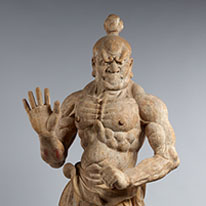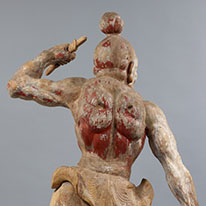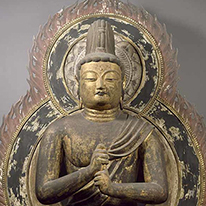Past Exhibitions
- Feature Exhibition: Olympia Meets Japanese Art
- June 5, 2021 - July 4, 2021
The Kyoto National Museum is pleased to present treasures from its collection to compare and contrast the ancient Olympics in Greece and religious folkways in Japan. The people of ancient Greece worshipped many gods and goddesses, and among the famous Panhellenic Games held to honor their deities, the most important and famous were the games held every four years at Olympia. Sacred ground to all Greeks, Olympia was a center of religious worship and the location of a magnificent temple to Zeus, lord of the heavens and almighty in the Greek pantheon. The athletes who competed at Olympia trained their minds and bodies to compete before these gods. The victors were feasted for days on end and gained the right to dedicate a statue of themselves on the temple grounds. In their home communities they were honored for the rest of their lives.
Like the ancient Greeks, Japanese since distant antiquity worshipped many deities, competed with each other in the presence of the divine, trained themselves mind and body, celebrated their victories, and feasted together with their gods.
This exhibit introduces art of Japan and East Asia that resonates with the stories and legends of the ancient Olympics, creating what we hope will be an opportunity to enjoy the arts of Asia while learning more about the world of ancient Greece.
*The open-mouthed a figure is displayed facing backward in order to reveal the muscles on its back.
Feature Exhibition: Olympia Meets Japanese Art
- Japanese Sculpture
- June 5, 2021 - July 4, 2021
What do Japanese sculptures depict? Before the Edo period, almost all Japanese statues were of deities or religious figures. Buddhist sculptures have been produced in Japan since Buddhism came to the archipelago in the seventh century. Japanese Buddhist deities often have origins in South Asia and the Himalayas. These were usually imported into Japan by way of China, bringing foreign influences with them.
One of the distinctive characteristics of Japanese sculpture is its use of wood as a primary material. Various modes of carving and other techniques—including joint-block construction (yosegi-zukuri) and inlaid crystal eyes—were developed in Japan to create these wood images.
The Japanese Buddhist sculptures on view here come from different historical periods. Their varied styles exemplify the repeated waves of influence from the Asian mainland as well as subsequent Japanese innovations.














